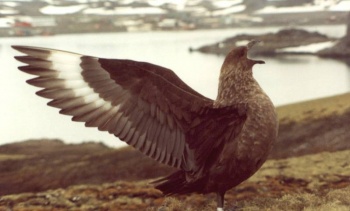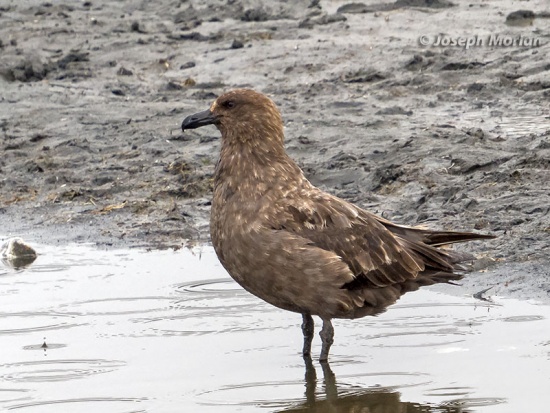m (→External Links) |
|||
| (19 intermediate revisions by 5 users not shown) | |||
| Line 1: | Line 1: | ||
| − | + | '''Alternative names: Southern Skua, Subantarctic Skua, Antarctic Skua, Falkland Skua''' | |
| − | + | [[Image:SubantarcticBrownSkuaIMG 1903.jpg|thumb|550px|right|Adult. Race ''S. a. lonnbergi'' <br />Photo © by {{user|jmorlan|Joseph Morlan}}<br />Salisbury Plain, [[South Georgia]], 5 March 2018]] | |
| − | [[Image: | + | ;[[:Category:Stercorarius|Stercorarius]] antarcticus<br /> |
| + | |||
==Identification== | ==Identification== | ||
| + | [[Image:12761Catharacta antarctica.jpg|thumb|350px|right|Race ''S. a. lonnbergi'' displaying<br />Photo © by {{user|Rodrigo+Tapia|Rodrigo Tapia}}<br />Ardley Peninsula, King George Island, South Shetland Archipelago, Antarctica, January 1992]] | ||
| + | Size: 52-64 cm (20½-25¼ in), wing 35.5-40.2 cm, wingspan 126-160 cm, females on average are larger in most measurements, most noticeably in wing length.<br /> | ||
| + | Nominate subspecies | ||
| + | *Brown overall plumage, variable from light to dark | ||
| + | *Pale streaking above | ||
| + | *Dark cap (often reduced to a mask in light morph birds) | ||
| + | ====Variations==== | ||
| + | Other races are larger, darker and less streaked above. Juveniles uniformly dark. | ||
==Distribution== | ==Distribution== | ||
| − | + | Circumpolar Subantarctic islands, Antarctic Peninsula, Tristan da Cunha and Gough Islands; [[Falkland Islands]] and southern [[Argentina]] from Chubut to Tierra del Fuego. | |
==Taxonomy== | ==Taxonomy== | ||
| − | Brown Skua | + | This species has been placed in the genus [[:Category:Catharacta|''Catharacta'']] with the other large skuas (Sibley & Monroe, 1993; Clements, 2000). |
| + | |||
| + | Older texts and some current field guides will treat Brown Skua as a part of [[Great Skua]]. | ||
| + | ====Subspecies==== | ||
| + | [[Image:Southern_Skua.jpg|thumb|350px|right|Nominate race<br />Photo © by {{user|zweiblumen|zweiblumen}}<br />East Cove, [[Falkland Islands]], 2004]] | ||
| + | There are 3 subspecies<sup>[[#References|[1]]]</sup>: | ||
| + | *''S.a. antarcticus'' breeds in the [[Falkland Islands]], and south-east [[South America]]: Smallest, most heavily streaked. | ||
| + | *''S.a. hamiltoni'' breeds on Tristan da Cunha and Gough Island: Larger, darker, narrower streaks. | ||
| + | *''S.a. lonnbergi'' breeds on the [[Antarctica|Antarctic Peninsula]] and Subantarctic Islands: Like ''S. a. hamiltoni'' but larger. | ||
| + | |||
| + | The subspecies ''lonnbergi'' has been treated as a full species ''Stercorarius lonnbergi'' by some authorities.<sup>[[#References|[2]]]</sup> | ||
| + | |||
==Habitat== | ==Habitat== | ||
| + | Pelagic. Inland (during breeding season) | ||
==Behaviour== | ==Behaviour== | ||
| − | |||
| − | |||
| − | |||
| + | ====Breeding==== | ||
| + | [[Image:SubantarcticBrownSkuaIMG 1936.jpg|thumb|350px|right|Juvenile. Race ''S. a. lonnbergi'' <br />Photo © by {{user|jmorlan|Joseph Morlan}}<br />Salisbury Plain, [[South Georgia]], 5 March 2018]] | ||
| + | Oct-Nov onwards, on flat grassy areas or short grass heaths. Nest is an unlined or sparsely so, scrape. 1-2 eggs, incubated 28-32 days, young leave nest within 1-2 days and fledge in 40-50 days. Sexual maturity at six years. | ||
| + | ====Diet==== | ||
| + | Scavenger at refuse tips, predates penguin eggs and chicks and burrow nesting seabirds at night. | ||
| + | ==References== | ||
| + | #{{Ref-Clements6thAug17}}#Avibase | ||
| + | #BF member observations | ||
| + | #Handbook of the Birds of the World Alive (retrieved May 2018) | ||
| + | {{ref}} | ||
==External Links== | ==External Links== | ||
*[http://www.birdforum.net/showthread.php?t=63072&highlight=skua+australia This thread discusses both identification and taxonomy of different Skua species and subspecies] | *[http://www.birdforum.net/showthread.php?t=63072&highlight=skua+australia This thread discusses both identification and taxonomy of different Skua species and subspecies] | ||
| − | {{GSearch|Stercorarius | + | <br /> |
| − | + | ||
| + | {{GSearch|"Brown Skua" {{!}} "Stercorarius antarcticus" {{!}} "Southern Skua" {{!}} "Subantarctic Skua" {{!}} "Antarctic Skua" {{!}} "Falkland Skua" {{!}} "Catharacta antarctica" }} | ||
| + | |||
| + | {{GS-checked}}1 | ||
| + | <br /> | ||
| + | <br /> | ||
| − | [[Category:Birds]] | + | [[Category:Birds]] [[Category:Stercorarius]] |
Latest revision as of 21:48, 17 April 2023
Alternative names: Southern Skua, Subantarctic Skua, Antarctic Skua, Falkland Skua
- Stercorarius antarcticus
Identification

Photo © by Rodrigo Tapia
Ardley Peninsula, King George Island, South Shetland Archipelago, Antarctica, January 1992
Size: 52-64 cm (20½-25¼ in), wing 35.5-40.2 cm, wingspan 126-160 cm, females on average are larger in most measurements, most noticeably in wing length.
Nominate subspecies
- Brown overall plumage, variable from light to dark
- Pale streaking above
- Dark cap (often reduced to a mask in light morph birds)
Variations
Other races are larger, darker and less streaked above. Juveniles uniformly dark.
Distribution
Circumpolar Subantarctic islands, Antarctic Peninsula, Tristan da Cunha and Gough Islands; Falkland Islands and southern Argentina from Chubut to Tierra del Fuego.
Taxonomy
This species has been placed in the genus Catharacta with the other large skuas (Sibley & Monroe, 1993; Clements, 2000).
Older texts and some current field guides will treat Brown Skua as a part of Great Skua.
Subspecies
There are 3 subspecies[1]:
- S.a. antarcticus breeds in the Falkland Islands, and south-east South America: Smallest, most heavily streaked.
- S.a. hamiltoni breeds on Tristan da Cunha and Gough Island: Larger, darker, narrower streaks.
- S.a. lonnbergi breeds on the Antarctic Peninsula and Subantarctic Islands: Like S. a. hamiltoni but larger.
The subspecies lonnbergi has been treated as a full species Stercorarius lonnbergi by some authorities.[2]
Habitat
Pelagic. Inland (during breeding season)
Behaviour
Breeding
Oct-Nov onwards, on flat grassy areas or short grass heaths. Nest is an unlined or sparsely so, scrape. 1-2 eggs, incubated 28-32 days, young leave nest within 1-2 days and fledge in 40-50 days. Sexual maturity at six years.
Diet
Scavenger at refuse tips, predates penguin eggs and chicks and burrow nesting seabirds at night.
References
- Clements, J. F., T. S. Schulenberg, M. J. Iliff, D. Roberson, T. A. Fredericks, B. L. Sullivan, and C. L. Wood. 2017. The eBird/Clements checklist of birds of the world: v2017, with updates to August 2017. Downloaded from http://www.birds.cornell.edu/clementschecklist/download/
- Avibase
- BF member observations
- Handbook of the Birds of the World Alive (retrieved May 2018)
Recommended Citation
- BirdForum Opus contributors. (2024) Brown Skua. In: BirdForum, the forum for wild birds and birding. Retrieved 14 May 2024 from https://www.birdforum.net/opus/Brown_Skua
External Links
GSearch checked for 2020 platform.1






